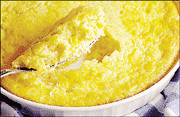|
|||||||||
White Perch, Roe and Spoon Bread: A Spring RitualNothing ever tasted so goodby Joan LehmannWhen I was a child, on the first warm day of spring each year, my father announced we were going fishing. My brother and I quickly turned over every brick and rock in Mom’s flowerbeds to search for earthworms to put in a tin can for bait. We also shoved acorns and stones into our pockets. Mom packed bologna and cheese sandwiches and a jug of sweet tea into our cooler. Pop loaded the fishing poles, cooler and us into the truck, and we were off for our adventure. Pop drove a blue 1956 Chevy pickup. By the early 1970s, it had seen better days. The seats were ripped, and it took two hands to turn the steering wheel. Pop never had a key and started the ignition with a screwdriver. There was a hole in the floorboard, and my brother and I took turns dropping things through the hole and turning quickly to look out the back window to watch them bounce on the asphalt. That’s where the acorns and stones came in. Pop had a secret fishing hole on the Patuxent River off of Sand’s Road. From April to June, white perch leave the brackish waters of the Chesapeake and head upriver to fresh water to spawn. We used earthworms and purple worms on our hooks to catch them. Sometimes the river was so full of white perch, you could see them teeming under the water’s surface. On a good day, we could catch a dozen nice sized fish in an hour or two. Along with the white perch, we caught some yellow perch, catfish and an occasional trout or herring. Pop wouldn’t eat catfish from a pond; they tasted too muddy. But he would skin a cat from the river. Cats will bite on almost anything, and we caught some with dough balls mixed with canned yellow corn. We never liked cleaning yellow perch. It seemed like their scales were on backwards and wouldn’t come off. If we caught a big one, Pop kept it and filleted it to bypass the scaling. Except for the trout, which were few and far between, Pop favored the sweet, juicy meat of the white perch, especially the females whose bellies were swollen with roe. We couldn’t wait to get home to shuck our muddy shoes and show Mom our catch. We cleaned the whole mess of fish on newspaper on our picnic table in the back yard. We loved popping the air bladders with the tips of our paring knives and looking through the insides for hooks, lures and purple-worm remnants. Mom carefully lifted the fragile sacs of roe into a pan of saltwater for later. She coated the fish with salt, pepper and flour and fried them golden brown; then she cooked the roe the same way, only at a lower temperature. If the sacs got too hot too fast, they exploded, and tiny, sticky fish eggs flew all over the kitchen. She served the fish with white rice, pickled beets and spoon bread. About the only time we got spoon bread was when the fish were running. It’s a concoction of cornmeal, milk, eggs, shortening, salt and baking powder; something like a wet cornbread. It is stiff enough to stand your knife in, but wet enough you need a spoon to dole it out. I peeled the crispy skin and white sweet meat from the fish backbone. I nibbled the meat from the fin bones. I licked my fingers and wiped them on my napkin before I picked up my fork to follow it through with a bite of hot spoon bread, dripping with melted butter. Sometimes Mom held the roe back to have for breakfast. The crispy sacs of eggs had a delicate fish flavor, and of course there were no bones to pick. She served it with leftover spoon bread, if there was any. Only for breakfast, it was covered with King’s syrup, instead of butter. That spoon bread recipe is still on the back of the Indian Head white corn meal bag. I have put the word out to my fisherman buddies that I’d like to have a few white perch if they can spare some, preferably with roe. I can’t wait to share this family tradition with my children, complete with pickled beets and rice. I’ll even give them some roe and spoon bread for breakfast — if they’re lucky. Now and again, Baltimore-Washington Medical Center fast track emergency room physician Joan Lehmann tells her stories for Bay Weekly. She’s putting the finishing touches on a medical memoir called Don’t Move Rosa. |
|||||||||
|
|||||||||
|
© COPYRIGHT 2008 by New Bay Enterprises, Inc. All rights reserved. |
|||||||||
 Volume 16, Issue 17 - April 24 - April 30, 2008
Volume 16, Issue 17 - April 24 - April 30, 2008
